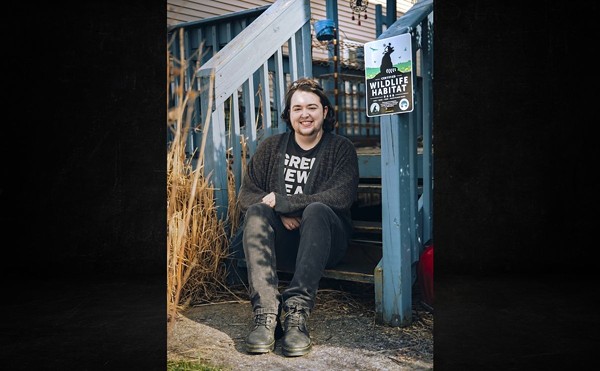Critic's Pick
Bestiary sweeps through all three rooms of Manifest Gallery in a lively embodiment of the kind of show the East Walnut Hills gallery has to a degree pioneered and does well.
An idea (in this case “animals”) is thrown out worldwide thanks to the Internet, and a stringent jury/curatorial process sifts the keepers from what is usually a heady number of submissions. This time, 410 artists submitted images of 985 works. Twenty-five works by 17 artists, from France, Canada and England, in addition to the U.S., made the cut. No one local is among them, but they are a happily diverse assemblage. The show includes drawings, prints, paintings and sculptures as well as excursions into video, photography and digital collage.
These animals are not necessarily cuddly. In the front gallery, Minneapolis-based Jessica Teckemeyer's “Reliance (Sinners and Saints)” immediately states the dichotomy of our relationship with animals. She has cast a pair of black heads of what seem to me an undetermined animal (wolf? dog?) and, with only tiny differences in the mouth and lines around the eyes, made one fearsome and one friendly.
Nearby, in reverse anthropomorphism, Susan Sterling (Arlington, Texas) works over two found objects (monkey-like animal forms) to produce self-portraits of a sort. For “Autobiography” and “She Loves to Travel but She Never Has,” Sterling covers these pieces with tiny beads, inserts doll eyes and alters the feet to end in doll arms. The result is a pair of nervous-looking, oddly endearing creatures that look dressed up but perhaps have nowhere to go.
Hard to miss in the front gallery are three big canvases by Rosalind Tallmadge (Bloomington, Ind.), who also looks to the simian world. These arresting works are painted in loose strokes that include suggestions of human figures. “Howler,” “Baboon” and “Golden Snub-Nose” all show animals in open-mouthed cry, but we can't even see the heads of the humans.
“Sea of Memory” by Noriko Kuresumi (Astoria, N.Y.) is an extraordinarily beautiful, porcelain, shell-like piece, asking the viewer to wonder what it once held as well as to admire its lovely form.
For his “Wild Animals” video in the second gallery, Steven Snell (Northampton, Mass.) has appropriated imagery/narration from Marty Stouffer’s Wild America television series so that the genial host only speaks animal names. “Wildcat,” Stouffer says, smiling. He says it again and again, then he's off to another species. The work speaks to our fascination with the animal world but also hints that we might be a bit patronizing about it all.
On the wall above Snell's constantly commenting television screen is a splendid tour de force. In “Basilisk,” Justin Gibbens (Thorp, Wash.) shows us the titular mythical reptile — a king of reptiles, according to legend, whose glance could kill — morphing into a rooster, scales giving way to overlapping feathers in a most intriguing fashion. I'm not sure what the message is here — the rooster's crow was supposed to be the one sure way to kill the basilisk — but the work itself is both striking and beautiful, with a Japanese influence evident. It's on two large sheets of paper; the image created with watercolor, gouache, ink and tea.
Another attention-gatherer in the same room is Laara Cassells’ “Neither Sheena Nor Cloud,” in which a blindingly white horse shares space with a girl in a blindingly white dress. But she is less present than the horse, thanks to cell phone and ear buds. Cassells, a Canadian artist, has a sure hand; each paint stroke counts.
Anna-Lena Gremme's video projection fills an entire wall in the third gallery and is the only work shown there. “Baby Dolls” necessitates an abrupt re-thinking of human interaction with other animals, as many of the previous works have suggested we only think we have the upper hand. Here our potential for thoughtless behavior is tragically displayed. The Parisian artist has videotaped a wall full of puppies in cages, as if on display in a pet store, each little beast striving to get out. Contingent thoughts can turn on any imposition of one species over another.
Some of the earliest art known, cave paintings, were representations by humans of animals in their world. Bestiary shows us we're still at it.
BESTIARY is on view at Manifest Creative Research Gallery in Walnut Hills through Dec. 3. Get show and gallery details here.





